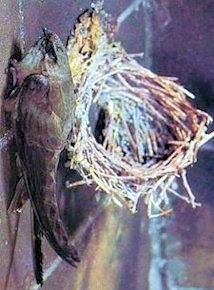
|
Apodiformes
Families 3:
|
3. Apodiformes - Swifts and Hummingbirds Taxonomists often categorize these two groups of small, strong-flying birds -- swifts and hummingbirds -- in the order Apodiformes, though a close relationship between the two has been disputed. The family of swifts includes some 70 species, whose members live nearly worldwide. A small group of Southeast Asian birds, the crested-swifts, are placed in their own family. Swifts superficial resemblance to swallows is a result of evolutionary convergence. Swifts are highly aerial birds that hunt insects while flying. Their wings are long and slender, and their flight is rapid and agile. Many species of swifts attach their nests to a vertical surface with a sticky salivary secretion. In certain parts of the world -- especially in the Far East -- nests entirely of saliva are the key ingredients in bird's nest soup, which many consider a delicacy. The short legs and wing shape of hummingbirds and swifts are quite similar: both species have long flight feathers with extremely short wing bones. The more than three hundred species of hummingbirds, all in the Western Hemisphere, show a dazzling array or iridescent plumage. The long thin bills may be straight or strongly curved and short to extremely long and are adaptations for feeding at different types of flowers. ⇦ Back to 2 Screamers On to 4 Kiwis ⇨Return to Bird Type Choices Page 1 Return to Oregon Birds |
| Chimney Swift | ||
|
Some species of hummingbirds feed mainly on small invertebrates, such as insects and spiders, but the majority feed on nectar. Hummingbirds are active and territorial birds that often defend nectar sources aggressively. Some temperate-zone and high-altitude species enter a torpid state of inactivity and lowered body temperature on cooler nights to conserve energy. |
||